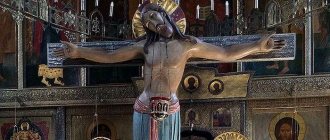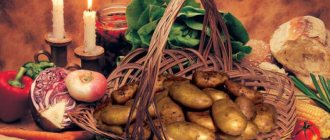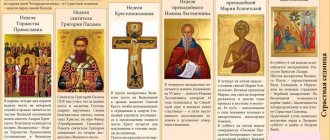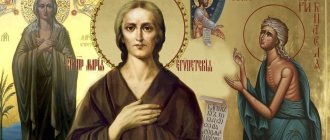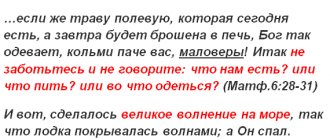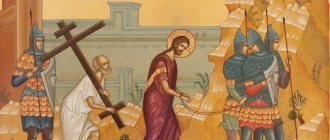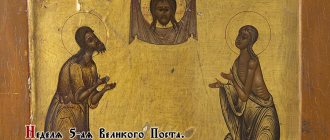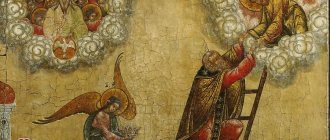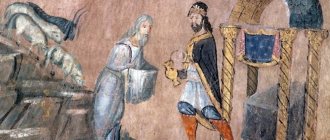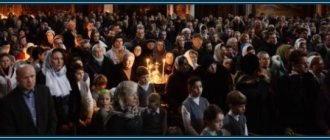First week of Holy Pentecost (Lent)
Pentecost begins on Clean Monday. Apart from Palm Sunday, there are 5 Sundays throughout Lent, each of which has a special holiday (some kind of reminder of the events in the life of Christ). As for divine services, throughout Lent, liturgies are not held on Mondays, Tuesdays and Thursdays: they are considered the most strict in observing the rules of fasting. The only exceptions are major church holidays. On these days, only morning and evening services are held, the main theme of which is to gain the will and not allow the demon to tempt the spirit of the Orthodox. On Wednesdays and Fridays, Liturgies of the Presanctified Gifts are held. Every Saturday a service is held for St. John Chrysostom. On Sundays they serve the Liturgy of St. Basil the Great, and it is also served on Thursday and Saturday, the week before Easter.
During the first four days, the Great Canon of St. Andrew of Crete is read in all Orthodox churches.
On the fifth day of Lent, the Liturgy of the Presanctified Gifts is served. First, they read the canon about the holy great martyr Theodore Tyrone. After this, “kolivo” (boiled porridge with honey) is brought into the hall and the minister blesses it with a special prayer in order to then distribute this gift to all parishioners.
During the first Sunday, the Triumph of Orthodoxy is held. This holiday was established during the time of Queen Theodora in 842. It commemorates the spiritual victory of Christians at the 7th Ecumenical Council. At the end of the liturgy, the priest reads a prayer service in the middle of the church, surrounded by the faces of Mary and the Savior.
Gospel in memory of the 40 Martyrs of Sebaste
The Day of Remembrance of the 40 Martyrs of Sebaste is celebrated on March 22 according to the new style.
Gospel of Matthew, chapter 20, 1 - 16
1 For the kingdom of heaven is like an owner of a house, who went out early in the morning to hire laborers for his vineyard, 2 and having agreed with the laborers for a denarius per day, he sent them into his vineyard; 3 When he went out about the third hour, he saw others standing idle in the market place, 4 and he said to them, “Go you too into my vineyard, and whatever comes next I will give you.” They went. 5 He went out again about the sixth and ninth hour and did the same. 6 Finally, going out about the eleventh hour, he found others standing idly, and he said to them, “Why have you been standing here all day idly?” 7 They said to him, “No one hired us.” He says to them: You also go into my vineyard, and whatever comes next, you will receive. 8 When evening came, the lord of the vineyard said to his steward, Call the workers and give them their wages, beginning from the last to the first. 9 And those who came about the eleventh hour received a denarius. 10 Those who came first thought that they would receive more, but they also received a denarius; 11 And when they received it, they began to murmur against the owner of the house, 12 and said, “These last worked one hour, and you made them equal to us, who endured the hardship of the day and the heat.” 13 He answered and said to one of them, “Friend!” I don't offend you; Did you not agree with me for a denarius? 14 Take what you have and go; I want to give this last one the same as you; 15 Do I not have the power to do whatever I want? Or is your eye envious because I am kind? 16 So the last will be first, and the first last, for many are called, but few are chosen.
The parable of the vinedressers has a deep meaning. It clearly separates the value systems of the workers and the owner of the vineyard. Workers believe that payment for their work depends on the result (this is earthly logic), and the owner is ready to pay everyone the same amount (heavenly logic). This is how Christ reveals to his listeners that God’s mercy is not proportional to our efforts, explains Archpriest Pavel Velikanov (reading the Gospel in Russian and the full interpretation here).
Second, third and fourth weeks of Holy Pentecost
On the second Sunday of the forty-day fast, the Russian Orthodox Church remembers St. Gregory Palamas. He was the Archbishop of Thessalonites and lived in the 14th century. His teachings consisted in the idea that for good deeds in the Christian life the Savior will illuminate with a gracious light all who believe and bestow upon them his blessing.
On the third Sunday of the forty-day fast, the Great Doxology is held and the sacred cross is brought out for veneration. But the cross is displayed not only for worship: first of all, parishioners are reminded of the feat of Jesus. And these reminders, in turn, inspire and strengthen parishioners in faith to continue fasting. This holy crucifix is left for veneration only until Friday. It is because of this event that the third Sunday of the Holy Pentecost is called the Sunday of the Cross.
On the fourth Sunday, they remember Saint John of the Climacus, who wrote about the rules of good deeds that lead believers to the Throne of God.
On the eve of the fifth Thursday, they perform the “Standing of the Most Holy Mary of Egypt,” also called the “Standing of Mary.” This is the morning service at which the Great Canon of St. Andrew of Crete is read. It is this canon that is read at the beginning of the forty-day fast. Also at this service they read “the life of the Most Holy Mary of Egypt.” By the way, Mary of Egypt was a great sinner before coming to Christ, but her true repentance should still be an example of God’s unspeakable mercy.
About reading the Bible in Church and at home.
Reading the Holy Scriptures is a necessary part of Orthodox worship. “Let the Word of Christ dwell in you richly, with all wisdom,” says St. Apostle Paul (Col. 3:16). The Bible consists of the books of the Old and New Testaments. During the church year, all the books of the New Testament are read in church, except the Apocalypse, as well as many books of the Old Testament, in whole or in part. Just as in the times of the apostles, when, according to the book of Acts, the word of Christian preaching was often combined with the daily reading of the Holy Scriptures (Acts 17:11), so now the word of God is heard in church services every day .
There is a pious tradition of Orthodox Christians to be edified daily by the words of Holy Scripture, reading the Gospel and the Apostle chapter by chapter. Also, many, having calendars with indications of church readings, follow them and read passages of Scripture texts according to the day.
The Monk Nikon of Optina said this about reading the Bible : Constant spiritual singing and reading Scripture is the food of the soul, this is its decoration, this is its protection. On the contrary, not listening to Scripture is hunger and destruction for the soul. If you don’t understand something, then accept it by simple faith; for God Himself said it.
We present to your attention a section of the site that contains the texts of the readings of the Holy Scripture according to the statutes of the Orthodox Church during the period of singing the Lenten Triodion (it includes the preparatory Weeks, starting with the Week of the Publican and the Pharisee, the period of Great Lent - Holy Pentecost and Holy Week). This includes excerpts from the Apostle and the Gospel, as well as Parimia - excerpts from Old Testament prophecies about the Savior and His Feat on the Cross.
Sixth week of Holy Pentecost
The sixth Saturday of Lent is also called Lazarus. Services on this day are distinguished by their unusual warmth and value. At liturgies, Orthodox parishioners remember how Jesus Christ raised Lazarus. During morning services, troparia for the Immaculates are sung.
Sunday is the Bright Feast of the Entry of the Lord into Jerusalem. This holiday is also called Palm Sunday. At night services, the Gospel is first read, and then “The Resurrection of Christ” is sung. They read Psalm 50 from the Gospel, sanctifying themselves with prayer and blessed water. Willow branches are also blessed. After consecration, they are distributed to all those praying. With these willows you need to defend the entire service with burning candles. This symbolizes the triumph of life over the all-consuming, but eternally losing faith, death.
Memory of Saint Gregory Palamas
(based on materials from the site pravsobor.kz)
Each week of Lent carries a certain meaning and meaning. So, the meaning of the first week
Great Lent - the Triumph of Orthodoxy was that a new truth of the Orthodox faith was revealed. And when, after this first Sunday of Great Lent, we entered the second week, we were already walking a new path.
Which way?
The fact is that an icon depicting God, as taught by the holy fathers who established the veneration of icons, may be combined with some of the properties of God because God the Creator Himself inscribed
His image, His icon,
. Every person carries within himself the living image of God. And the goal of the aspiration of fasting, the aspiration of all our deeds - repentance, prayer, our requests - is the aspiration to reveal in us the image of God, which is inscribed in our nature, in our nature by the hand of God the Creator Himself. It has become easier to breathe, it has become better to live, we become cleaner, seeing where we are going, and why we are going, and what we are asking God for.
Second week
, the second Sunday of Great Lent puts our mental, spiritual gaze before the teaching of Saint Gregory Palamas about the image of God in us, because we ask ourselves:
“What is the “image of God” inscribed by God Himself in us?
What is it? What is he like? What is he? And Gregory Palamas answers precisely this question. Saint Gregory Palamas wrote many works, but one of his greatest works, the most important, is the so-called “Tomos of Faith”. And in it the saint says that the image of God in us is, first of all, light, not physical light, but the same light that shone on the Lord Jesus Christ on Mount Tabor at the hour of His wondrous Transfiguration. This is the light of the glory of God, and the image of God in man is a ray of this glory of God. A person with the image of God in himself does incredible things - he cripples him, defiles him, darkens him. We know this. But perhaps not everyone knows that this image is still indestructible. Man cannot destroy the image of God in himself due to God’s mercy towards us. He is indestructible!
And it is inherent in each of us, this light not made by hands, the ever-present light of the glory of God, revealed on Mount Tabor at the hour of the Transfiguration of the Lord.
Christ said that the Kingdom of God is also within us. Now, in order to reveal it in yourself, you need to obey the Church, you need to accept its maternal leadership, you need to give your hands to the Mother Church. And she, taking you by this hand, will certainly lead you to the happiness of revealing in yourself all the best, the most sacred thing that can be - participation in the Divine.
And now, when the images of the saints pass before us, let us remember that they are not only people who were illuminated in mind, purified in heart, but that these are people who accepted God, just as iron can be pierced with fire, and who have become on earth the vision of that to which all creation is recognized.
Maslenitsa in 2022
The tradition of baking pancakes is acceptable, because dairy products are not prohibited during Cheese Week.
Maslenitsa is a preparatory week for Lent, which should be devoted to good communication with neighbors, family, friends, and charity. The Church calls to remember that you should not have unbridled fun, losing your head and conscience.
- March 8, 2022 (Monday)
3rd preparatory week for Lent. Cheese week is all about it. Meat food is excluded.
Meeting Maslenitsa . According to folk traditions, on this day there was a meeting of matchmakers who determined when and where the wedding of the young people would take place.
- March 9, 2022 (Tuesday)
Flirting. Time to watch unmarried girls. People rode down the slides and ate pancakes. If young people formed new couples, the goal was to get married after Easter.
- March 10, 2022 (Wednesday)
Gourmand. The son-in-law went to his mother-in-law for pancakes, the mother-in-law showed her daughter’s husband every kind of affection. The tradition of baking pancakes is acceptable, because dairy products are not prohibited during Cheese Week. Orthodox Christians can also bake pancakes during Maslenitsa and invite each other to visit. According to the charter of the Church, these days you can no longer eat meat, but you can still eat dairy products and fish.
The Lenten prayer of St. Ephraim the Syrian is read in churches.
- March 11, 2022 (Thursday)
The beginning of Broad Maslenitsa . Folk festivities began. Each Christian must decide for himself how much he can participate in Maslenitsa entertainments, how relevant they are at the moment for his spiritual life. Communicating with relatives and friends at the holiday table will not harm anyone: there is an opportunity to meet, try to understand another, reconcile with someone, in order to enter into fasting with a clear soul and a clear conscience.
- March 12, 2022 (Friday)
Mother-in-law's parties. Now the mother-in-law was going to visit her son-in-law, and his wife, the mother-in-law’s daughter, was preparing pancakes.
The Lenten prayer of St. Ephraim the Syrian is read in churches.
- March 13, 2022 (Saturday)
Sister-in-law's get-togethers. On this day, young women invited their sister-in-law and other relatives of their husband to visit.
- March 14, 2022 (Sunday)
It's a damp week. Memories of Adam's exile. Conspiracies for Great Lent.
Forgiveness Sunday . On this day, after the evening service, a special rite of forgiveness is performed in churches, when clergy and parishioners mutually ask each other for forgiveness in order to enter Lent with a pure soul, reconciled with all their neighbors.
Lent is a time of exerting spiritual strength and acquiring virtues. At this time, people try to cleanse their souls in order to prepare for Easter. Therefore, during wide celebrations, fist fights, noisy games and traditions of burning effigy on Maslenitsa, one must be careful that they interfere with preparations for fasting. Any abuse distances a person from God and from acquiring those qualities of the soul that a Christian strives for.
About Orthodox worship
The last week before Easter is dedicated to the last days of the earthly life of Christ the Savior, His Passion and death on the cross for the sake of our salvation. That is why this week is called Passion Week. And according to the importance and significance of the events that took place in it, it is also called Great, and each of its days is called Great: Great Monday, Great Tuesday... The divine service of this week, starting with Vespers, which is served in the evening on Vaiy Sunday, gradually leads us in the footsteps of the Lord , coming to a free death. With attention and reverence, the Holy Church follows Christ the Savior these days, remembering the events that filled the last days of Christ’s earthly life. The service is performed only according to the Triodion; services to the saints from the Menaion are read at Compline on the previous days. On Monday, Tuesday and Wednesday of Holy Week it is necessary to read the Gospel during the Hours (according to modern practice, the Gospel is read throughout Lent) - completely from Matthew, Mark, Luke and John to the 14th chapter, to the words: “Now the Son is glorified Human". Reading the Gospels reveals the whole life of the Savior. Also, in the first three days of Holy Week, the Liturgy of the Presanctified Gifts is served, which includes a specific Gospel reading. The Gospel is also read at Matins. At Compline these days the three hymns of the Triodion are read, and also at Matins instead of the full canon. At Matins on Monday, Tuesday and Wednesday the troparion is sung : “Behold, the Bridegroom comes at midnight, and blessed is the servant, whom he will find vigilant, but unworthy again, he will be found despondent.” Take care, my soul, not to be burdened with sleep, lest you be given over to death, and be shut out of the Kingdom. But arise, calling: Holy, Holy, Holy art thou, O God, have mercy on us through the Mother of God.”
.
Christ is called the bridegroom here. This troparion was compiled in imitation of the Gospel parable about the Ten virgins who came out at midnight to meet the Bridegroom. The Resurrection of Christ took place at midnight, and the Second Coming of the Lord - the Bridegroom of our souls, according to the tradition of the Church, will be at midnight. This chant encourages us not to indulge in the sleep of sin, to remain awake in soul, striving on the path of salvation. This troparion is supposed to be sung slowly and “with sweet singing.” At Matins on Monday, Tuesday, Wednesday and Thursday the luminary (exapostilary) is sung: “ I see Your palace, my Savior, adorned, and I will not put on my clothes, but I will bring them in: enlighten the robe of my soul, O Light-Giver, and save me
.”
This luminary is supposed to be sung three times, slowly, “with sweet singing.” First, in the middle of the temple by one singer and then repeated by the choir. This song reminds us of the Gospel parable about the man who entered the wedding feast in inappropriate clothing. He says that in order to enter the Hall of the Bridegroom, the Heavenly Kingdom, the bright clothes of virtues are necessary. Starting from Maundy Thursday, the entire service is dedicated to the Way of the Cross of the Savior. These services are completely special; they cannot be compared with any other services, first of all, in terms of internal content, although they differ in form. Holy Monday
The Lord spent the last nights before suffering outside Jerusalem. Returning to the city in the morning from Bethany and feeling hungry, Christ saw a fig tree. The time for figs had not yet arrived, but this tree had the leaves that usually appear after the fruit, so it could be assumed that it was one of the later fig trees, on which the fruit sometimes lasts all winter. This same fig tree was barren. Then the Lord said: “Let there be no fruit from you forever,” after which the tree immediately withered. According to the interpretation of the holy fathers, this fig tree, firstly, serves as a prototype of the Jewish host, from whom the Lord did not find the fruits of true faith and love. Also, as St. John Chrysostom speaks about this, Christ constantly had mercy, healed, and resurrected, but He had to reveal Himself as a Judge, Who would not condone untruth and wickedness. And for this, the Lord chooses a fig tree - a tree that grows everywhere in Palestine and had no price. And this fig tree, being barren, did not benefit anyone. A barren fig tree is also every soul that does not bear spiritual fruit, for which it will be condemned. Saint Isidore Pelusiot also notes that the paradise Tree of disobedience, the fruits of which Adam and Eve tasted, violating God’s prohibition, was a fig tree. From the leaves of this tree they sewed a covering for themselves. Having entered the city, Christ went straight to the temple, where he denounced those who violated decorum, who turned the porch of the temple into a market place, and drove out the traders. On Monday of Holy Week, the Holy Church also remembers the Old Testament righteous man - Joseph the Beautiful
- which served as a prototype of the Passion of the Lord. Righteous Joseph, out of envy, was thrown into a dark ditch by his brothers, and then sold by them into slavery in Egypt for thirty pieces of silver. Joseph suffered a lot in Egypt and was thrown into prison, suffering for his chastity. But God made him a master from a slave. And when there was a prolonged famine in Joseph’s homeland, the righteous man saved his father and his brothers, feeding them and forgiving their brothers for their sin against him. So Christ, through the envy of his fellow Jews, was betrayed for thirty pieces of silver. And having accepted Suffering, he rose from the grave, forgiving His enemies. Reigns over Egypt, i.e. over all sin and conquers it to the end, and possesses the whole world. And he humanely redeems us and feeds us with Heavenly Bread - His Life-Giving Flesh (as the synaxar of Holy Monday tells). At Matins there is the troparion “Behold the Bridegroom comes at midnight...”, the three-canticle of the Triodion, there is no complete canon. Svetilen: “I see Your palace, my Savior...” The Gospel reading at Matins tells of the Lord's curse of the barren fig tree and of the Savior's conversation in the Temple of Jerusalem, when the Lord gives two parables exposing the hypocrisy and ostentatious piety of the Jews, devoid of true faith, love and obedience to the Heavenly Father. The second parable - about the winegrowers - also covertly pointed the listeners to Christ as the Messiah. The Gospel reading at the Liturgy of the Presanctified Gifts tells about the fate of the apostate Jewish people, the destruction of Jerusalem by the Romans and the end of the world. Great Compline is served, and the Trisong is sung. A word from Archpriest Artemy Vladimirov about the barren fig tree. Sermon on Holy Monday, April 21, 2008.
Maundy Tuesday
After spending the night again in Bethany, Christ continued his conversations with the people in the Jerusalem Temple. The Gospel reading of Matins on Holy Tuesday tells us about this. The Pharisees, hoping to catch and convict Jesus of something, sent their people to him, then the Sadducees began. But the Savior’s wise answers put both of them to shame. And again the Lord secretly indicates that He is the Christ, the expected Messiah. After this, turning to the people, He delivers a denunciation of the hypocrisy of the Pharisees and scribes, concluding with the words: “Jerusalem, Jerusalem, who kills the prophets and stones those sent to you! How many times have I wanted to gather your children together, like a bird gathers its chicks under its wings, but you did not want to! Behold, your house is left to you empty. I say to you: you will not see Me from now on until you cry, “Blessed is he who comes in the name of the Lord.” After this, Christ left the temple and was no longer in it. On Tuesday of Holy Week, the hymns of the Triodion remind us of the Gospel parables - about the ten virgins and about the talents. The synaxarion of this day explains the meaning of the parable of the ten virgins. Virginity is a great feat, but it has no value without other virtues, without mercy and love. By sleep in this parable we mean death, after which no one will be able to make up for the lack of oil - works of mercy. This parable encourages us to always be vigilant and be ready to meet the Bridegroom with good deeds, and above all, with alms. For none of us knows the day and hour of our death. At Matins there is the troparion “Behold the Bridegroom comes at midnight...”, the two hymns of the Triodion (contains only the 8th and 9th cantos), there is no complete canon. Svetilen: “I see Your palace, my Savior...” The Gospel reading at the Liturgy of the Presanctified Gifts consists of two parables - about the Ten Virgins and about the talents. Great Compline is served, and the Trisong is sung. Word by Archpriest Artemy Vladimirov on the parable of the Ten Virgins Sermon on Holy Tuesday, April 22, 2008.
Great Wednesday
On Wednesday of Holy Week at Matins, the Gospel reading tells us how the Greeks (that is, converts to the Jewish faith from pagan peoples) wanted to see Jesus. And the Lord in response speaks about His ministry, about His upcoming suffering and death, about the mystery of the salvation of the human race. “The hour has come that the Son of Man may be glorified... now my soul is troubled, and what shall I say? Father, save Me from this hour: but for this hour I have come. Father, glorify Your name! A voice came from Heaven: I will glorify and glorify again..."
And further:
“Now is judgment for this world; now the prince of this world will be cast out.
And even if I am lifted up from the earth, I will draw everything to Me. This is the verb, signifying the death by which you want to die...”, “I have come as light into the world, so that whoever believes in Me shall not remain in darkness...”, “I have not come to judge the world, but to save the world...” . On Great Wednesday, the events of that day are remembered in hymns and in the Gospel reading at the Liturgy: the woman who anointed the Lord with myrrh, and the betrayal of Judas. When Jesus was in Bethany, where He spent the nights, He was in the house of Simon the leper. Then a woman (a sinner, a harlot) came up to Him and poured precious myrrh on the head of the Savior. The disciples were indignant that it would be better to sell such an expensive ointment and give the money to the poor. But the Lord told them that with this the woman prepared Him for burial and that her deed would be told all over the world through the preaching of the Gospel. Recalling the proximity of His death, the Lord also wants to turn Judas away from betrayal. But the money-loving Judas, who in the community of disciples was tasked with carrying a cash box (and Judas secretly stole from it), was so upset by the loss of profit that he finally fell under the influence and deception of the devil. Then Judas went to the Jewish leaders and offered to betray Jesus to them. They gave Judas a price of thirty pieces of silver for this. At Matins there is the troparion “Behold the Bridegroom comes at midnight...”, the three-canticle of the Triodion, there is no complete canon. Svetilen: “I see Your palace, my Savior...” Small Compline is served, and the trisong is sung. Sermon by Archpriest Artemy Vladimirov Conversation on Holy Wednesday, April 21, 2011. About the Jesus Prayer and the communion of the Holy Mysteries of Christ. (mp3 24.5 MB)
Maundy Thursday
On Holy Thursday, the Last Supper took place, at which the Lord taught the Sacrament of His Body and Blood, the sacrament of Holy Communion. The time has come for the Jewish Passover. Having completed all the Old Testament ritual establishments of the Easter supper, having celebrated the Passover of the Old Testament, the Lord establishes the New Testament and teaches the disciples Holy Communion. Having blessed the bread, He handed it to the disciples with the words: “Take and eat: this is My Body, which was broken for you for the remission of sins.”
.
Then he blessed the cup of wine: “Drink from it, all of you.
This is My Blood of the New Testament, which is shed for you and for many, for the remission of sins .
At this supper, Christ also showed the disciples an example of humility by washing their feet. The Gospel reading of Matins tells about this. Saint Innocent of Kherson suggests that the dispute between the disciples about which of them was greater arose precisely because of the washing of the feet, which had to be done before the Easter supper. There was no servant in the community, and someone had to perform this custom and wash the feet of others. But no one wanted to do this, the students argued among themselves about primacy. And then the Lord Himself began to wash everyone’s feet, instructing them to learn humility. In Christ’s farewell conversation with his disciples after the establishment of the Sacrament of Communion, the Lord reveals to them the secret of His ministry, the essence of His teaching. He comforts and strengthens the disciples for the trials ahead. At the Liturgy, the Gospel reading is more extensive and leads us further after the Lord - to the Garden of Gethsemane, where the Lord prayed before His Passion and was betrayed by Judas to the guards he brought. The disciples were sleeping, and the Lord, fearing for humanity suffering and painful death, prayed three times to the Heavenly Father, that His cup of suffering would pass. But the strength of spirit and devotion to the will of God forces Christ to add: “Not Mine, but Thy will be done!” In the Garden of Gethsemane, the Lord experienced the full weight of internal suffering, suffering of the spirit. The cup of impending suffering and death was filled with human sins, the sins of the whole world, which Christ took upon Himself in order to redeem humanity from the curse of sin, to heal human nature damaged by the fall. This is precisely what made the Lord’s inner suffering so difficult and painful - his soul was tormented and oppressed by the sins of the whole world, which He took upon Himself. In deep spiritual sorrow, Jesus wanted to encourage the disciples to pray together, but they were weighed down by sleepy relaxation. The languor of the God-man was so strong that the sweat that appeared, according to the Evangelist Luke, was like drops of blood falling to the ground. Three times Christ knelt in prayer, remaining without an answer from the Heavenly Father, since He Himself had to utter the answer to Himself, through self-denial achieving that unity with the Father in which all doubt disappears. But the love of the Heavenly Father did not leave the Savior without help - an Angel appeared from Heaven, strengthening Him. That night Judas, who had finally betrayed the Lord, brought guards from the high priests to take Jesus. The guards and servants needed some kind of sign indicating the One against whom they were sent. The traitor chose kissing for this: “Whomever I kiss is He, take Him.” Christ, knowing what would happen, woke up all the disciples and went out to meet the traitor. Still wanting to reason with the unfortunate Judas, the Lord asked him: “My friend, why are you here?” But Judas did not heed the Savior’s love and kissed Him, thereby giving the agreed sign to the soldiers. “Judas, wilt thou betray the Son of Man with a kiss?” - the Lord asked him. The guards did not dare to grab Him, amazed by the mysterious power emanating from Him. Twice He asked them whom they were looking for. “Jesus the Nazarene,” answered the guards. “It is I,” answered the Lord, remaining in place and waiting for the soldiers to seize Him. He only cared about the disciples, telling them to let them go. And He gave Himself into the hands of the guards. Peter was about to grab a knife and cut off the ear of one of the servants, but the Lord stopped Peter and healed the ear of the wounded servant. After this, all the disciples fled in fear, only John and Peter remained, who followed the Teacher. The enemies of Christ were in an extreme hurry, so the Savior was brought straight to the house of the high priest. Here also occurs the triple denial of Peter, predicted by the Lord, who was afraid that he would also be captured. At Matins - the troparion “When the glorious disciple is enlightened at the thought of the supper, then the evil Judas, sickened by the love of money, becomes darkened, and betrays You, the Righteous Judge, to the lawless judges.
See, the steward of the estate, who used strangulation for these sake! Flee the unsatiated soul, such a daring Teacher. O God of all, O Lord, glory to Thee!” .
Canon of Maundy Thursday. Svetilen: “I see Your palace, my Savior...” At the 1st hour, the prophecy of the Old Testament prophet Jeremiah about the suffering of the Savior is read, in which Christ is compared to a lamb led to the slaughter. On this day, the Liturgy is served according to the rite of St. Basil the Great, combined with Vespers. Instead of the Cherubic hymn, instead of the sacrament and instead of “Let our lips be filled...” the hymn is sung : “To Thy Mystical Supper this day, O Son of God, accept me as a partaker, for I will not tell the secret to Thy enemy, nor will I kiss Thee like Judas, but like a thief I will confess Thee.” “Remember me, O Lord, in Thy Kingdom
.
After the prayer behind the pulpit in cathedrals, the Rite of Washing the Feet
, in which it is depicted how Christ washed the feet of the disciples, and the Gospel telling about this is read. The bishop depicts Christ, and the archimandrites or priests represent the 12 disciples. In Jerusalem, the Rite of Washing the Feet is performed in the square in front of the Church of the Resurrection of Christ; Christ is depicted by the Patriarch of Jerusalem. Small Compline is served, and the trisong is sung. Sermon by Archpriest Artemy Vladimirov on Maundy Thursday about communion of the Holy Mysteries of Christ Sermon by Archpriest Artemy Vladimirov after Matins with reading of the Twelve Gospels on April 16, 2009 (MP3 12.8Mb)
Good Friday
Good Friday, Great Friday - in Slavic. Easter of the Cross. With incredible haste, the scribes and Pharisees manage to hold two meetings throughout the night, find and listen to false witnesses, pronounce condemnation, and hand over the Lord to Pilate for crucifixion. Over the course of several hours, the Savior endured torture from three different authorities - Jewish (Sanhedrin), Galilean (Herod) and Roman (Pilate). What means do the Jewish elders resort to in order to achieve their goal! A certain slowdown in the trial of Pilate, who for a long time did not dare to condemn the Innocent, gave them a chance to see their mistake and come to their senses. But they use this time to turn the people against Christ. The Savior of the world was ridiculed, desecrated, and suffered painful mockery. The terrible traces of these sufferings were captured on the Shroud of the Savior (the funeral linen in which the body of the Lord was wrapped during burial), now kept in the Italian city of Turin. On the cloth of the Shroud there were traces of blood from many wounds inflicted on the Lord Jesus Christ. The Romans carried out flagellation with ropes or belts, into which sharp metal or bone sticks were inserted in places. Each whip had from one to five ends, to which sinkers were attached - lead spikes or bones, so that the lashes would grip the body more tightly and tear the skin. This punishment caused such suffering that the condemned often died under the lashes. The entire body of the Divine Sufferer is strewn with terrible lacerations and traces of scourging. As the Shroud testifies, two warriors beat - one tall, the other shorter. According to forensic experts who studied the Shroud, Christ was tied to a pole by his raised arms and beaten first on the back, and then on the chest and stomach. According to Jewish law, it was not allowed to inflict more than 40 blows on the defendant. In Rome there was no such restriction. The Savior received 98 lashes! On the Shroud there are traces of 59 blows of a whip with three ends, 18 with two ends, 21 with one end. Each contusion with laceration is approximately 3.7 cm in length. A crown of thorns was placed on Christ’s head, which had the shape of a cap, and not a hoop, as is commonly believed. The thorns hurt especially painfully when the soldiers beat the Lord on the head with a cane. Each blow caused deep wounds. On the Sufferer’s head there are about 30 streaks of blood from punctures made by thorns. Numerous injuries on the face: broken eyebrows, torn right eyelid, large swelling below the right eye, damaged nose, bruise on the right cheek, injury on the left cheek and chin. There are traces of nail wounds on the arms and legs. On the body there is an oval mark from a spear strike. The Shroud also imprinted a deep mark from the heavy beam of the cross on the right shoulder of the Savior and traces of the fact that Christ repeatedly fell under the weight of this burden. During the fall, the knee was broken, and the heavy beam of the cross hit the back and legs, causing damage. Jesus Christ, among all these tortures and sufferings, showed amazing greatness of spirit. As the prophet Isaiah once said: “Like a lamb that is led to the slaughter, so it does not open His mouth. In His humility His judgment..." (Is. 52:7), "My cloaks were put on the wounds and My cheeks on the blows, but I did not turn away My face from the cold of spitting" (Is. 8), "The same wound was for our sins , and to be tormented for our iniquities, the punishment of our peace is upon Him; by His stripes we are healed.” Few of the Lord's answers to the judges express the highest wisdom. He twice confirmed to the Jews that He was the Messiah they were waiting for. But, blinded by anger and envy, they did not heed. The execution of the cross, to which Jesus Christ was condemned, belongs to the inventions of inhuman cruelty and was the most terrible, most painful and shameful of executions. For many hours, the crucified man experienced increasing acute pain in his wrists and feet, pierced by nails, the unnatural position of his chest caused suffocation, his whole body seemed to be on fire and torn to pieces. The man was very thirsty. The slightest movement caused unbearable pain. Blood rushed to the head and heart, causing dizziness and heartache. They died on the cross long and painfully. The Romans only subjected slaves to this execution. Among the Jews it meant a curse: “Cursed is everyone who hangs on a tree” (Deut. 21:23). “In Old Testament times, the cross meant complete rejection and complete destruction. If hell has a bottom, then the cross marked the bottom of hell. Therefore, Christ chose crucifixion as a form of suffering that combines all mental and physical torment. The blood of Christ, which stained the Cross, atoned for the sins of mankind” (Archimandrite Raphael (Karelin) [11]). Before the crucifixion, the condemned were given an intoxicating drink to drink, but the Lord refused it, wanting to endure everything in full consciousness. According to church tradition, the Cross of the Savior consisted of three types of wood: cypress, pine (pine) and cedar. According to custom, the crucified person was stripped naked, and his clothes went to the soldiers who carried out the execution. Added to other torments was extreme humiliation, the shame of nakedness. Plates were nailed over the heads of the condemned, indicating their name and crime. Despite all the ferocity of suffering, the Savior until the last minute shows amazing dignity and greatness. Instead of groaning from terrible pain - silence, love, prayer. The measure of love and long-suffering of the Lord, incomprehensible to human consciousness, is revealed to us, Who, for the sake of love for us, endured the most severe physical and mental suffering and, in the midst of the very suffering, contained within Himself the fullness of love even for those who mocked Him and tortured Him. “Father, forgive them! “They don’t know what they are doing,” - this is how Christ prayed for His enemies and crucifiers. The Cross of Christ consisted not only of bodily suffering. The Savior on the Cross experienced the severity of the sins of the whole world, retribution for them, the suffering of all mankind, merged into one. Christ on the Cross “... tasted the flames of hell, kindled by the sins and crimes of people. The Creator of eternity and time compressed eternity into the limits of time on the Cross. The eternal torment and pain of the Universe gathered into a single cup, and this cup of black flame was drunk to the dregs by the soul of the God-man. ...That hellish fire, which was destined for all mankind forever for its sins, those terrible sufferings the Lord had to endure on the Cross. …The sinner experiences abandonment by God. And this abandonment of God, the complete loss of God, is, as the Holy Fathers say, more terrible than all other torments. And Christ experienced it. Therefore He exclaimed: “My God! My God! Why have you forsaken me?
(Mark 15:34). ...Only eternity will reveal the secret of what happened on Golgotha” (Archimandrite Raphael (Karelin) [11]). Nature itself could not bear the lawlessness that was happening, the desecration of its Creator. The sun faded and darkness fell. As soon as the Lord gave His spirit into the hands of the Father, an earthquake occurred, so strong that many rocks and tombs cracked. In the Temple of Jerusalem itself, an amazing sign appeared - the curtain separating the Holy of Holies (the last of the three parts of the Temple, where even priests were forbidden to enter) from the Sanctuary, suddenly tore from top to bottom. This indicated that the Messiah had come, that on Calvary the Lamb of God, taking away the sins of the world, was sacrificed for the whole world. And now the throne of grace, previously hidden behind this veil, is available to everyone. The entire service of this day is dedicated to the remembrance of the suffering and death of the Savior on the cross. At Matins of the Great Heel, 12 Gospel readings are read, telling about the events of these days, starting with the Last Supper, then about the betrayal and suffering of the Savior, His death on the cross and burial. Those praying in the church listen to these Gospel readings with lit candles. It is customary to not extinguish the candle after the last reading and bring this fire home. Also at Matins of this day, special antiphons and blessed ones are sung. The first hour is not connected to Matins, but is served separately, together with other hours. The Liturgy is not celebrated on Great Friday, because on this day the Sacrifice was made on Golgotha. On this day there is a strict fast. In the morning, the Royal Hours are celebrated - the 1st, 3rd, 6th, 9th with the singing of special troparions and the reading of Old Testament prophecies, the Apostle and the Gospel about the redemptive feat of Christ the Savior. At Vespers, which takes place at the third hour of the day, at the hour of the death of Jesus Christ on the Cross. At Vespers, during the singing of the troparion “Blessed Joseph from the tree, I will take down Your Most Pure Body...” the clergy lift the Shroud (the cloth with the image of the Lord lying in the tomb) from the Throne, as if from Golgotha, and is carried to the middle of the temple. The Shroud is in the middle of the temple until the evening of Holy Saturday. The majestic sorrow that permeates the chants of the Great Heel can hardly leave anyone indifferent. Although there is nothing sensual in it (as, for example, in the works of famous composers dedicated to the Passion of the Lord), this grief touches to the depths of the soul. Small Compline is served. The amazing canon “The Lamentation of Our Lady at the Cross” is read on it. Sermon by Archpriest Artemy Vladimirov after Matins with reading of the Twelve Gospels Sermon by Archpriest Artemy Vladimirov on Good Friday at the Shroud Sermon on Good Friday, April 25, 2008 Sermon by Archpriest Artemy Vladimirov on Good Friday, April 17, 2009 after the Royal Hours (MP3 21.1Mb) Sermon after removal The Shroud on Good Friday, April 2, 2010. (MP3 9Mb) Sermon after the Royal Hours on April 22, 2011. (MP3 9Mb) Sermon on Good Friday, April 22, 2011 after the removal of the Shroud. (mp3 6 MB) About the Shroud of Turin
Holy Saturday
Great Most Blessed Saturday - this is what the Holy Church calls this day, singing at the Liturgy instead of the Cherubic Song: “Let all human flesh remain silent, and let it stand with fear and trembling, and let nothing earthly think within itself: the King of kings and the Lord of lords comes to sacrifice and to be given as food to the faithful. Then came the faces of angels with all authority and power, many-eyed cherubim and six-winged seraphim, covering their faces and crying out the song: Alleluia, Alleluia, Alleluia.” The body of Jesus Christ was taken down from the Cross and buried in a cave that belonged to Joseph of Arimathea, a secret follower of Christ. According to Jewish custom, the body of Christ was anointed with incense and entwined with a wide quadrangular cloth - the shroud. The entrance to the cave where the Savior was buried was blocked with a huge stone. The anger of the Sanhedrin also guessed that they would place a guard at the tomb, since the Jewish leaders were afraid that the disciples would secretly take away the Teacher’s body and say that He had risen. And the disciples forgot at that hour all the Lord’s predictions about the Resurrection. Their hearts, loving the Teacher, were filled with great sorrow. The synaxarion of this day says that Holy Week surpasses all the days of Lent, but in Holy Week itself the greatest day is Great and Holy Saturday. And just as at the creation of the world, having created man on the sixth day, on the seventh day God rested from all His works and sanctified the seventh day. So now, the Lord, on the sixth day, having recreated human nature corrupted by sin, renewing it with the Life-Giving Cross and death, rested on this day. Christ - the Word of God - descends from the flesh into the tomb, and descends into hell with His incorruptible and Divine soul. But in hell the Lord’s soul could not be contained; the power of death was destroyed by the redemptive feat of the Savior. Christ brings out of hell the souls of the righteous who had been there until that time. At Matins on Holy Saturday the 17th Kathisma is sung. After each verse of the kathisma, short hymns are sung or read, dedicated to the redemptive feat of the Savior, His burial, glorifying the Lord. These chants are called “Praises”. Kathisma is divided into three parts or "articles", which correspond to the division of kathisma into "glories". After each article there is a small litany. After the third article, before the litany, the Sunday troparia “The Council of Angels Surprised” are sung. When singing the 17th kathisma with “Praises,” the clergy with lighted candles stand in front of the Shroud. Worshipers also stand with candles. After the singing of the Great Doxology, while singing “Holy God...”, the Shroud is raised and carried out of the temple by the clergy and carried around the temple, thereby depicting the burial of the Lord. The rector holds the Gospel in his hands and walks under the Shroud, and the priests carry the Shroud, raising it. The carrying of the Shroud is preceded by those walking with candles and two lamps. The Shroud is followed by praying people. After bringing the Shroud back into the temple, the troparion “Blessed Joseph...” is sung and a paremia is read, which tells the vision of the prophet Ezekiel about the future resurrection of the dead. Then follows the reading of the Apostle, which says that the Lord is our Easter, our Redeemer, and the Gospel is read, which tells about the sealing of the Holy Sepulcher and the placing of guards over it. The Liturgy is served according to the rite of St. Basil the Great and is combined with Vespers. At Vespers, at “I have cried to the Lord,” the Sunday stichera of the 1st tone are already sung. After the chant “Quiet Light,” 15 proverbs are read. After reading the 6th proverb, which tells about the miraculous passage of the Jews through the Red Sea, the singers sing the words of the Biblical song “Gloriously is he glorified.” The reading of the proverbs consists of singing the song of the three youths: “Sing to the Lord and exalt to all ages.” At the liturgy, instead of the Trisagion, “Those who were baptized into Christ were baptized, they put on Christ...” is sung, reminiscent of the custom of baptizing catechumens on Holy Saturday. Then the prokeimenon is sung, “Let all the earth worship Thee and sing to Thee...”, after which the Apostle is read. After the apostolic reading, before the reading of the Gospel, instead of “Alleluia,” a verse from Psalm 81 is sung: “Arise, O God, judge the earth, as You have inherited in all nations,” interspersed with the proclamation of the remaining verses of Psalm 81. During this singing in the altar, the clergy change their vestments from black guard vestments to white ones. The vestments of the throne and lecterns in the temple are also changed to white. Thus, by the time the Gospel is read, which announces the resurrection of the Lord, everything is dressed in light clothes. Instead of the Cherubic song, the song “Let all human flesh be silent...” is sung. Instead of “Worthy” - the irmos of the 9th song of the canon: “Do not weep for Me, Mother, seeing in the tomb, Who in your womb without seed you conceived a Son: for I will arise and be glorified and exalt with glory unceasingly as God, who magnifies You with faith and love.” . Participated - “Arise, as the Lord sleepeth, and is risen to save us.” After the liturgy there is a blessing of bread and wine, with which they previously strengthened themselves for listening to the reading of the book of the Acts of the Apostles and the subsequent Easter service, because in ancient times, the liturgy on this day was served in the evening. According to modern practice, the liturgy on Holy Saturday is celebrated in the morning. In the evening, the book of the Acts of the Apostles is read (in full), followed by the Midnight Office, on which the canon of Holy Saturday is sung. At the end of the Midnight Office or during it, all clergy in vestments reverently carry the Shroud to the altar and place it on the throne. The Shroud remains on the throne until the Feast of the Ascension of the Lord, in memory of the forty-day stay of Jesus Christ on earth after the Resurrection. Sermon after Matins on Holy Saturday, April 2, 2010. (MP3 15Mb) Sermon after Matins on Holy Saturday, April 22, 2011 (mp3 4.4 MB)
